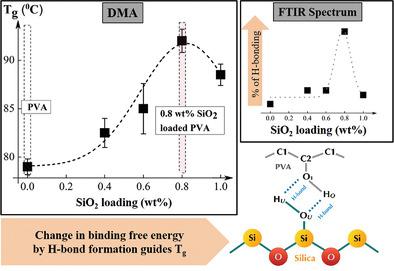当前位置:
X-MOL 学术
›
Macromol. Rapid Commun.
›
论文详情
Our official English website, www.x-mol.net, welcomes your feedback! (Note: you will need to create a separate account there.)
Elucidating the Role of Interfacial Hydrogen Bonds on Glass Transition Temperature Change in a Poly(Vinyl Alcohol)/SiO2 Polymer-Nanocomposite by Noncovalent Interaction Characterization and Atomistic Molecular Dynamics Simulations.
Macromolecular Rapid Communications ( IF 4.6 ) Pub Date : 2020-09-11 , DOI: 10.1002/marc.202000240 Ritwik Panigrahi 1 , Souvik Chakraborty 2 , Jun Ye 2 , Geraldine S Lim 2 , Freda C H Lim 2 , Joachim Khin Hun Yam 3 , Linda Yongling Wu 3 , Shuyun Chng 3 , Melissa Prawirasatya 1 , Alexander M van Herk 1 , Praveen Thoniyot 1
Macromolecular Rapid Communications ( IF 4.6 ) Pub Date : 2020-09-11 , DOI: 10.1002/marc.202000240 Ritwik Panigrahi 1 , Souvik Chakraborty 2 , Jun Ye 2 , Geraldine S Lim 2 , Freda C H Lim 2 , Joachim Khin Hun Yam 3 , Linda Yongling Wu 3 , Shuyun Chng 3 , Melissa Prawirasatya 1 , Alexander M van Herk 1 , Praveen Thoniyot 1
Affiliation

|
A thorough experimental investigation of polymer‐glass transition temperature (Tg) is performed on poly(vinyl alcohol) (PVA) and fumed silica nanoparticle (SiNP) composite. This is done together with atomistic molecular dynamics simulations of PVA systems in contact with bare and fully hydroxylated silica. Experimentally, PVA‐SiNP composites are prepared by simple solution casting from aqueous solutions followed by its characterization using Fourier‐transform infrared spectroscopy (FTIR), dynamic mechanical analysis (DMA), and dynamic scanning calorimetry (DSC). Both theoretical and experimentally deduced Tg are correlated with the presence of hydrogen bonding interactions involving OH functionality present on the surface of SiNP and along PVA polymer backbone. Further deconvolution of FTIR data show that inter‐molecular hydrogen bonding present between PVA and SiNP surface is directly responsible for the increase in Tg. SiNP filler and PVA matrix ratio is also optimized for a desired Tg increase. An optimal loading of SiNP exists, in order to yield the maximum Tg increase arising from the competition between hydrogen bonding and crowding effect of SiNP.
中文翻译:

通过非共价相互作用表征和原子分子动力学模拟阐明了界面氢键对聚(乙烯醇)/ SiO2聚合物-纳米复合材料中玻璃化转变温度变化的作用。
对聚乙烯醇(PVA)和气相二氧化硅纳米颗粒(SiNP)复合材料进行了聚合物-玻璃化转变温度(T g)的彻底实验研究。这与与裸露和完全羟基化的二氧化硅接触的PVA系统的原子分子动力学模拟一起完成。实验上,PVA-SiNP复合材料的制备方法是:从水溶液中进行简单的溶液浇铸,然后使用傅立叶变换红外光谱(FTIR),动态力学分析(DMA)和动态扫描量热法(DSC)对其进行表征。理论推导和实验推导的T g均与存在的氢键相互作用有关OH官能团存在于SiNP表面和PVA聚合物主链上。FTIR数据的进一步反卷积表明,PVA和SiNP表面之间存在的分子间氢键是T g增加的直接原因。SiNP填料和PVA基质的比例也针对所需的T g增加进行了优化。为了获得最大的T g增加,存在最佳的SiNP装载量,这是由氢键和SiNP的拥挤效应之间的竞争引起的。
更新日期:2020-11-06
中文翻译:

通过非共价相互作用表征和原子分子动力学模拟阐明了界面氢键对聚(乙烯醇)/ SiO2聚合物-纳米复合材料中玻璃化转变温度变化的作用。
对聚乙烯醇(PVA)和气相二氧化硅纳米颗粒(SiNP)复合材料进行了聚合物-玻璃化转变温度(T g)的彻底实验研究。这与与裸露和完全羟基化的二氧化硅接触的PVA系统的原子分子动力学模拟一起完成。实验上,PVA-SiNP复合材料的制备方法是:从水溶液中进行简单的溶液浇铸,然后使用傅立叶变换红外光谱(FTIR),动态力学分析(DMA)和动态扫描量热法(DSC)对其进行表征。理论推导和实验推导的T g均与存在的氢键相互作用有关OH官能团存在于SiNP表面和PVA聚合物主链上。FTIR数据的进一步反卷积表明,PVA和SiNP表面之间存在的分子间氢键是T g增加的直接原因。SiNP填料和PVA基质的比例也针对所需的T g增加进行了优化。为了获得最大的T g增加,存在最佳的SiNP装载量,这是由氢键和SiNP的拥挤效应之间的竞争引起的。


























 京公网安备 11010802027423号
京公网安备 11010802027423号